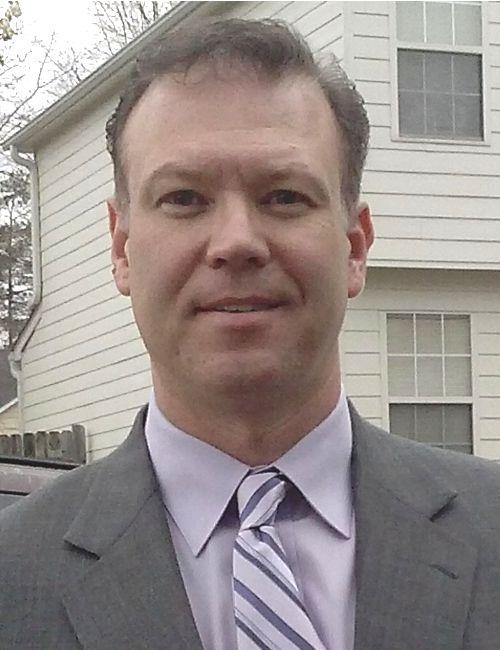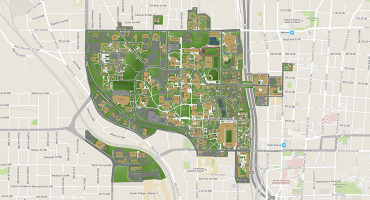In 2014, when Adam Decker started teaching the anatomy lab and lecture course BIOS 3753 in the School of Biological Sciences, he and his students relied on printed anatomy diagrams and plastic models of organs to understand the human body. Decker knew that many of his pre-health students would soon be on their way to medical schools elsewhere — and he worried that these undergrad classes would pale in comparison to what they’d later encounter as graduate students with more hands-on experiences.
“It just didn’t get the punch across like I wanted — for having the students know what a heart feels like in their hands, what a lung feels like,” says Decker, a senior academic professional in Biological Sciences at Tech. “Pieces of plastic are fine, and they serve a purpose — but it’s not the real deal like they would see in grad school.”
Student evaluations of his course would occasionally echo those same sentiments. Why couldn’t neuroscience students study an actual human brain to better understand how it works?
Those evaluations led Decker to explore how he could bring human cadaveric specimens and organs to Georgia Tech’s Atlanta campus for his students to study. The feedback from students now learning anatomy from those specimens is clear — Decker’s lab and course are among some of the fastest growing classes in the School, with students from a variety of disciplines showing interest — such as a biomedical engineering major who wants to design heart valves and is looking for hands-on experience, and an aspiring physician-astronaut “carving my own path to advance the intersections between medicine, engineering, and space exploration” as a dual major in biology and industrial engineering, with dual minors in social justice and physiology.
A related special topics course in pathology started by Decker could soon be a permanent addition to the School of Biological Sciences curriculum, with a growing base of young alumni who share that they’re now deciding on specialties in medical school based on their experiences in his classes.
“We are so lucky to have Adam as an instructor at Georgia Tech,” says Michael (Mike) Goodisman, an associate professor in the School of Biological Sciences. “Adam has great reviews from the students in his classes. They can see how passionate he is about understanding human form and function. These are very difficult classes — but the students love them. And Adam is always trying to provide the most contemporary and exciting class experience possible.”
“This was the first time these specimens have been brought to campus,” Decker says. “The human side of our biology curriculum is really growing here. I’m just grateful to have had a part in that, developing courses and helping satisfy that need. It’s an exciting time to be in pre-health here.”
Adopting a new approach to anatomy
Creating these immersive courses took time, Decker says. His path to bringing cadaveric specimens to Georgia Tech involved two years of advocacy— phone calls, meetings, and negotiations with groups split across Georgia Tech and Emory University School of Medicine, along with teaming up with fellow School of Biological Sciences professors who supported the collaborative effort for campus.
Back in 2018, Decker signed up to teach with Georgia Tech’s Pacific Study Abroad Program, through which students travel to New Zealand and Australia for courses and cultural experiences. Decker was leading the Scientific Foundations of Health (APPH/BIOL1040) class there, and says the trip helped him decide to look at adding cadaver classes and labs to curriculum offerings back at Tech’s Atlanta campus.
On the south island of New Zealand, he explains, the University of Otago in Dunedin has a medical school with a popular Anatomy Museum, “where you could go in and they have all the prosections (specimens that demonstrate anatomic structure for students), all the cadaver organs, sections of tissues and bones, and anything you could think of related to the human body,” he says, “and it was open to the public.”
After peppering the curator with questions about the process of obtaining and hosting specimens, “I started thinking that there’s no reason we can’t do this back home. We don’t have a medical school — but Emory is right down the road.”
When he returned to Atlanta, Decker connected with colleagues at Emory University to see how cadaveric-based curricula might be made available at Georgia Tech, launching a multi-year effort with detailed requirements, and logistics — and a unique philanthropic program.
A team from Emory inspected the anatomy lab space on Tech’s campus, in a recently renovated building where courses and labs were planned. The group inquired about security arrangements, and laid down detailed rules and logistics for things like storage temperature, transportation, and appropriate humidity levels for specimens.
Regarding that last stipulation: Decker also happens to be a licensed embalmer in the state of Georgia. “I’m the guy who can keep the specimens preserved, and where they need to be, as far as preservation goes, and not pose a public health risk to the community. Emory liked that.”
The university also offered to help through a very unique philanthropic initiative — the Emory Body Donation Program. Decker explains that some of the cadaveric specimens that Emory and Tech’s future doctors, nurses, researchers, and founders study are thanks to generous individuals — often alumni — who, as the program notes, “wish to be useful to the living after death. We all cannot endow a hospital or establish a clinic, but each of us has the opportunity to make one valuable gift to medical science - the gift of his or her body after death.”
“This was something new for the school, I know,” Decker shares. “But the semesters were rolling by and students were missing the opportunity — because we were hung up” with finalizing paperwork and agreements across Emory and Tech.
So Decker reached out to his colleague Mike Goodisman, who made some calls and arranged a phone conference with both universities. The remaining questions and legal considerations were soon resolved, and Decker was invited to Emory to conduct dissections for the cadavers and specimens he would bring back to Georgia Tech.
“They left me with twenty cadavers. I was able to get multiple hearts and lungs, entire gastrointestinal tracts, brains, and a spinal cord,” he explains. “It took me seven hours to get the brain and spinal cord in one section — that specimen has proven valuable to the neuroscience majors. They want to see everything in one piece. These are really unique things that get the students excited.”
Student reaction, and respect for the specimens
Studying human hearts allows students to trace blood flow, something they could begin to learn from plastic models, but “it’s nothing like holding the real thing, and being able to trace the actual blood flow. It’s an amazing experience they get to have with this.”
That experience has prompted some graduates of Decker’s classes to even change their medical school plans. “Now they’re telling me they want to go into cardiology. They’re choosing a specialty because of this — and that’s the best experience, when you get them excited about something and they want to devote themselves to it.”
That energy is reflected in class attendance. The first human anatomy class Decker taught in 2014 had 66 students. In fall 2020, even with Covid-19, he had close to 295 students. “This is an upper elective 3000-level course. It’s almost unheard of to have almost 300 students.”
His senior-level human pathology course kicked off in 2019 as a special topic elective with 33 students. Decker is now running it for the second time, and has enrolled nearly 100 students.
“Dr. Decker has really done a great service to the students of Georgia Tech in bringing this course to life, so to speak,” says Young-Hui Chang, professor and associate chair for Faculty Development in the School of Biological Sciences. “He has worked incredibly hard to get us to the point where we can offer a unique cadaver-based human anatomy course to our undergraduate students. In particular, the students who have ambitions for a variety of health-related careers really benefit from this unique experience of learning from real human anatomy — and to learn it under the guidance of a truly gifted anatomist and teacher in Adam Decker.”
As to how students react to seeing specimens for the first time? “They’re usually very silent. Everybody is sitting down, nobody was talking. There’s almost a reverence you feel — as there should be. I tell them that this person loved somebody, lost somebody, went to school. You need to hold these specimens and have that reverence for them. These were people, and they’ve given the gift of themselves to help you learn.”
New technology applied to an ancient practice
Decker adds that anatomy is “pretty old school,” pointing out that dissections and naming of the body’s structures occurred in the 1500s. “Anatomy is a very old science, but it’s actually the basis of all health care. It’s the first course medical students take before they become doctors or nurses. You have to know what’s normal anatomy before you know what’s abnormal.”
Decker also wants to complement his anatomy and pathology courses by adding some new technology to traditional offerings. For instance, a California-based company, Anatomage, makes what it calls a virtual dissection table — essentially a typical human cadaver in digital form. A seven-foot-long “operating table” is basically a large flat screen with an image of a cadaver. By touching the screen, students can “cut away” tissue. Body parts are annotated, “so everything is labeled. It’s amazing. That’s where a lot of this is headed.”
Decker says Stanford University School of Medicine is now using the tables, and he’s put in a budget request in hopes of adding two of these tables to Tech’s campus.
In the meantime, he hopes to optimize storage and specifications so that students can work more directly with the specimens. Decker knows that his students would be ready to take on the challenge. “My anatomy class is not a typical undergrad course. It’s more of ‘one foot in medical school content, one foot in undergrad.’ It’s pretty intense, but I feel confident they will do well — and they always do.”
For More Information Contact
Renay San Miguel
Communications Officer II/Science Writer
College of Sciences
404-894-5209





